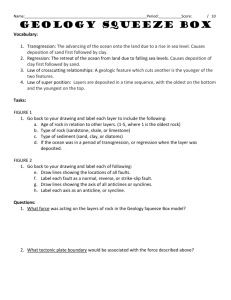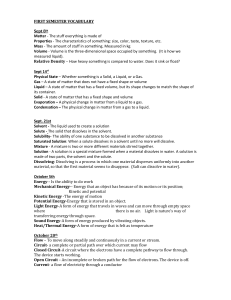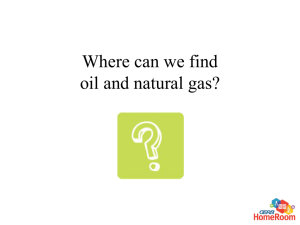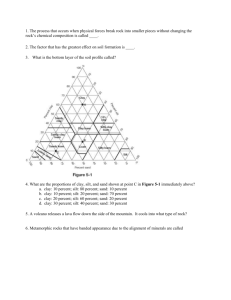Porosity and permiability
advertisement
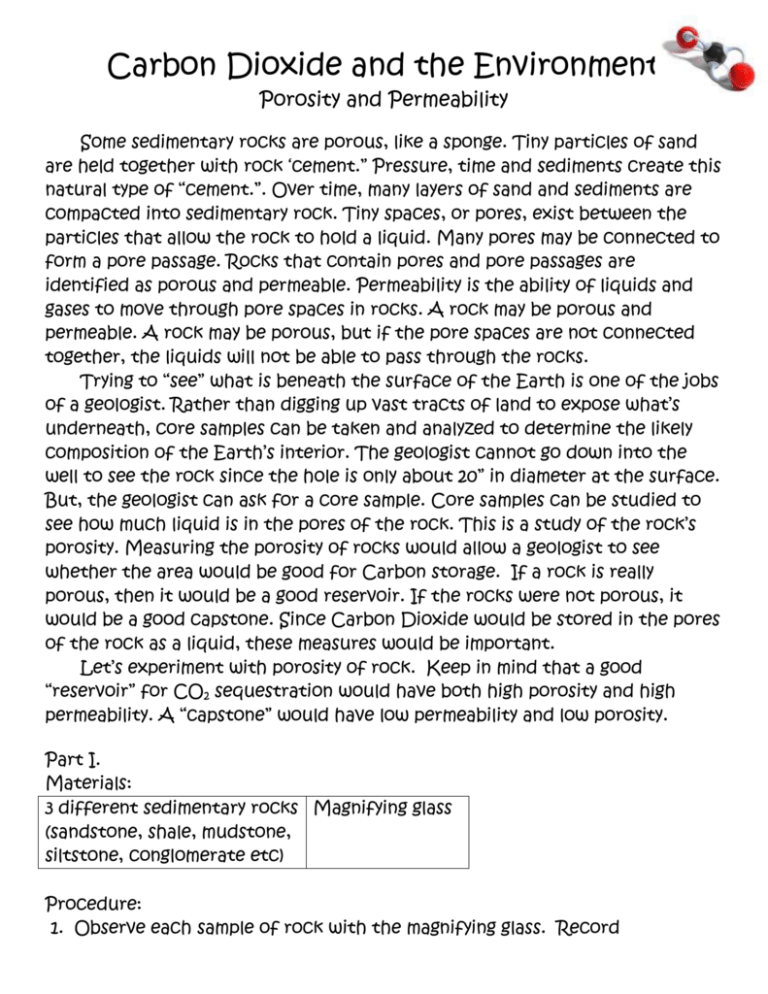
Carbon Dioxide and the Environment Porosity and Permeability Some sedimentary rocks are porous, like a sponge. Tiny particles of sand are held together with rock ‘cement.” Pressure, time and sediments create this natural type of “cement.”. Over time, many layers of sand and sediments are compacted into sedimentary rock. Tiny spaces, or pores, exist between the particles that allow the rock to hold a liquid. Many pores may be connected to form a pore passage. Rocks that contain pores and pore passages are identified as porous and permeable. Permeability is the ability of liquids and gases to move through pore spaces in rocks. A rock may be porous and permeable. A rock may be porous, but if the pore spaces are not connected together, the liquids will not be able to pass through the rocks. Trying to “see” what is beneath the surface of the Earth is one of the jobs of a geologist. Rather than digging up vast tracts of land to expose what’s underneath, core samples can be taken and analyzed to determine the likely composition of the Earth’s interior. The geologist cannot go down into the well to see the rock since the hole is only about 20” in diameter at the surface. But, the geologist can ask for a core sample. Core samples can be studied to see how much liquid is in the pores of the rock. This is a study of the rock’s porosity. Measuring the porosity of rocks would allow a geologist to see whether the area would be good for Carbon storage. If a rock is really porous, then it would be a good reservoir. If the rocks were not porous, it would be a good capstone. Since Carbon Dioxide would be stored in the pores of the rock as a liquid, these measures would be important. Let’s experiment with porosity of rock. Keep in mind that a good “reservoir” for CO2 sequestration would have both high porosity and high permeability. A “capstone” would have low permeability and low porosity. Part I. Materials: 3 different sedimentary rocks Magnifying glass (sandstone, shale, mudstone, siltstone, conglomerate etc) Procedure: 1. Observe each sample of rock with the magnifying glass. Record [Type text] [Type text] [Type text] observations like grain size, colors, spaces, etc.. Observations: Sample 1 Sample 2 Sample 3 Part II. Materials: 1 bag of large gravel 3-600 ml beakers 1 bag of sand 1 bag of small gravel Water colored with food coloring 1-100 ml graduated cylinder Procedure: 1. Fill one beaker to the 350 ml mark with large gravel. Fill another beaker to the 350 ml mark with small gravel. Fill a third beaker with 350 ml of sand. 2. Fill the graduated cylinder with 100 ml of water. 3. Slowly pour water in the first beaker until it reaches the top of the gravel. Record exactly how much water was poured into the beaker. (If you need more than 100 ml of water, fill the graduated cylinder again. 4. Follow step three for the other two beakers. 5. Calculate the porosity of the three materials using this formula: Porosity= volume of water ÷ volume of material x 100 Carbon Dioxide and the Environment Porosity and Permeability Data: Porosity Type of Material Volume (ml) of water poured Volume (ml) of material % pore space in material Large Gravel Small Gravel Sand Pore Space =Volume (ml) water poured into bottle ÷ Volume (ml) of substances in bottle X 100 1. What did you discover?_______________________________________. 2. What do you think would happen if you put gravel and sand together? Test and find out: _____________________________________________________________________________ ___________________________________________. Part III: Determining how pores space affects permeability. Prediction: I think the ____________sediment will have the most permeability, because ___________________________________________________. Materials 4 plastic cups with holes punched in the center Stop watch Coffee filters for each cup 2 beakers 4 types of sediment (sand, rock, clay, soil) Permanent marker [Type text] [Type text] [Type text] Procedure: 1. Place a coffee filter into each cup. 2. Label each cup with a sediment type.—one will be a sand cup, another will be a rock cup, another will be a clay cup, and the last will be a soil cup. 3. Put 100 mL of sand, rock, clay and soil in the appropriate cups. 4. Place the sand cup in an empty beaker, so you can measure the amount of water filtering through the sediment type. 4. Be ready to start timing flow soon. 5. Slowly pour water from a beaker or other water container into the plastic cup with one of the sediment types. Do one test at a time. 4. Keep the water level slightly above the top of the substrate in the plastic cup. 5. TART TIMING THE FLOW when the water starts to come out of the plastic cup and into the beaker. 6. STOP TIMING THE FLOW␣when the water level reaches 100 mL. 7. Share your data with 3 other groups to fill in Trial 2 and Trial 3. 8. Average the times and complete the calculations using the average time (mean). Data: Time in Minutes TYPE OF SEDIMENT Sand Rock Clay Soil Trial 1 Trial 2 Trial 3 Average Time (mean) Calculations: Permeability = volume of water (mL) divided by time in minutes. Sand: 100mL ÷ _______________min. = ______________mL/min. Rock: 100mL ÷ _______________min. = ______________mL/min. Clay: 100mL ÷ _______________min. = ______________mL/min. Soil: 100mL ÷ _______________min. = ______________mL/min. Carbon Dioxide and the Environment Porosity and Permeability Sand: Rock: Clay: Soil: Conclusions: (look over your data and your background information) 1. Which sediment (sand, rock, clay or soil) had the greatest permeability (most permeable)?____________________________. 2. Which sediment (sand, rock, clay or soil) had the least permeability (least permeable)?______________________________________. 3. Was your prediction correct? Why or Why not? ___________________________________________________________________ ______________________________________. 4. Based on what you have learned, which type of sediment would be better for a reservoir for geological carbon sequestration?_______________. 5. Color the pore space for each type of sediment. 6. Which has more porosity?________. [Type text] [Type text] 7. Which has more permeability?______. 8. Which would make a better reservoir for CO2 sequestration?_____? [Type text]

